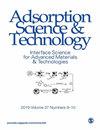Removal of Pb(II) from Aqueous Solutions with Manganese Oxide-Modified Diatomite
IF 3.2
4区 工程技术
Q2 CHEMISTRY, APPLIED
引用次数: 0
Abstract
In the present work, natural diatomite modified with manganese oxide (MnO2) was prepared via direct redox reaction with KMnO4 and HCl. The product was characterized by using X-ray diffraction, Fourier-transform infrared spectroscopy, scanning electron microscopy, transmission electron microscopy, energy-dispersive X-ray, and nitrogen adsorption-desorption isotherms. It was found that the nanorod manganese oxide was highly dispersed onto the diatomite porous matrix. The specific surface area of the obtained manganese oxide/diatomite () is larger than that of natural diatomite (). It was utilized to remove Pb(II) in aqueous solutions. It exhibits an excellent Pb(II) adsorption capacity. The adsorption data fits well with the pseudo-second-order kinetics model, and the adsorption process is endothermic and spontaneous with an activation energy of 41.56 kJ mol−1 and follows the Freundlich isotherm model. The Mn/diatomite adsorption capacity for Pb(II) is 81.42 mg g−1, calculated with the Langmuir model. In addition, the adsorption mechanism of Pb(II) onto Mn/diatomite is also addressed.氧化锰改性硅藻土去除水溶液中铅(II)的研究
采用KMnO4和HCl直接氧化还原法制备了氧化锰改性天然硅藻土。采用x射线衍射、傅里叶变换红外光谱、扫描电镜、透射电镜、能量色散x射线和氮吸附-脱附等温线对产物进行了表征。结果表明,纳米棒氧化锰高度分散在硅藻土多孔基质上。所得氧化锰/硅藻土()的比表面积大于天然硅藻土()。它被用于去除水溶液中的铅(II)。它具有优异的铅(II)吸附能力。吸附数据符合准二级动力学模型,吸附过程是吸热自发的,活化能为41.56 kJ mol−1,符合Freundlich等温线模型。根据Langmuir模型计算,Mn/硅藻土对Pb(II)的吸附量为81.42 mg g−1。此外,还研究了锰/硅藻土对Pb(II)的吸附机理。
本文章由计算机程序翻译,如有差异,请以英文原文为准。
求助全文
约1分钟内获得全文
求助全文
来源期刊

Adsorption Science & Technology
工程技术-工程:化工
CiteScore
5.00
自引率
10.30%
发文量
181
审稿时长
4.5 months
期刊介绍:
Adsorption Science & Technology is a peer-reviewed, open access journal devoted to studies of adsorption and desorption phenomena, which publishes original research papers and critical review articles, with occasional special issues relating to particular topics and symposia.
 求助内容:
求助内容: 应助结果提醒方式:
应助结果提醒方式:


